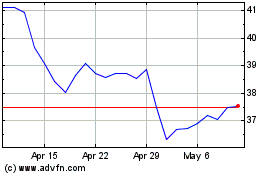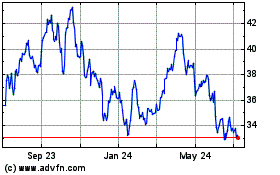By Tatyana Shumsky
More companies are giving investors the bad news first, in
response to heavier regulatory scrutiny of their financial
reporting.
More than a quarter of the companies in the S&P 500 index
have shifted results that conform with Generally Accepted
Accounting Principles to the top of news releases outlining their
most recent financial performance.
Among the S&P 500 companies reporting results since July,
81% have given prominence to GAAP figures, a sharp rise from the
52% that did so when reporting first-quarter results, according to
an Audit Analytics analysis conducted for The Wall Street
Journal.
Companies that have made the transition include Halliburton Co.,
Walgreens Boots Alliance Inc. and videogame maker Electronic Arts
Inc.
The uptick comes in response to new guidance issued by the
Securities and Exchange Commission in May that requires companies
to give GAAP figures greater weight. It reflects concerns that
adjusted or non-GAAP figures make companies look healthier.
The SEC's timing offered some breathing room, giving companies a
chance to comply with the guidance for subsequent reporting
periods, officials said.
"There's little appetite at the SEC for companies who don't
assess the guidance and self-correct," said Paula Hamric, a partner
in accounting firm BDO USA's national SEC practice.
Halliburton highlighted $64 million in "income from continuing
operations excluding special items" in its first-quarter press
release. But when reconciled to standard accounting principles, the
company had a loss of $2.4 billion.
By contrast, the Houston oil-field services company led its
second-quarter earnings release with a standard-accounting loss of
$3.73 per share, or $3.2 billion.
A Halliburton spokeswoman confirmed that the change was made to
comply with the SEC's new instructions.
The guidance leaves little room for flexibility. If a paragraph
or table contains standard and adjusted figures, companies must
make sure sentences or columns with the standard, or GAAP,
information precedes everything else.
Numbers must be also be presented in the same style, meaning
customized metrics can't be bolded or printed in a larger-size
font, nor can they be described as "record" or "exceptional" unless
GAAP results are characterized in a similar way.
Over the past two quarters, drugstore operator Walgreens has
switched around the sentences atop its earnings press release. The
company led its fiscal second-quarter earnings release with an 11%
increase in "adjusted net earnings," adding that standard per-share
results had plunged 56%. The following quarter, Walgreens put
standard results first, reporting a 14% drop in per-share
earnings.
"We did make some small changes to our most recent quarterly
earnings announcement based on the new SEC guidance and to further
enhance our disclosure to investors," said a spokesman for
Walgreens.
Some companies haven't yet made the shift. Software provider
Ellie Mae Inc. said in its second-quarter earnings release in July
that it hadn't yet modified "adjusted net income" to reflect
certain tax impacts -- a change now required by the SEC.
In a statement recently, Ellie Mae said it plans to comply with
SEC guidelines and modify the "adjusted" benchmark, but is
currently considering timing of the change. "Our measured approach
to transitioning the reporting of this financial metric will
balance our investors' expectations with the concerns of the SEC
staff," the company said.
Companies that don't make the necessary changes run the risk of
additional regulatory scrutiny in the form of letters and forced
revisions. in letters made public through Aug. 5, the SEC
questioned 166 companies this year regarding their use of non-GAAP
figures, up 13% from a year earlier, according to Audit
Analytics.
The SEC makes such written exchanges public 20 days after the
matter is resolved. The letters that have become public so far
concern financial reports from before the new guidance was
announced.
Accountants expect such correspondence to surge as the SEC
evaluates how companies handle the new requirement.
"It's an evolutionary process," said Jeffrey Jones, a partner in
KPMG's SEC practice. "The preparer community, the audit community,
the legal community as well as the SEC will be learning over the
next couple of months where the lines are."
Corporate chief financial officer may face a steep learning
curve. The SEC's new guidelines banned a number of metrics
previously considered acceptable. Regulators said that adjusting
results inconsistently or for recurring expenses could be
misleading.
Complying with the new parameters is more challenging and time
consuming than simply putting GAAP results at the front of the
press release. CFOs must re-evaluate whether the numbers they have
been reporting for years could be considered misleading in light of
the new guidance.
"You have investors and analysts that are used to seeing certain
metrics, so in order to change the presentation, [CFOs] have to
rethink what's meaningful going forward," said BDO USA's Ms.
Hamric.
In July, Electronic Arts Inc. became the first of three
videogame makers to announce it would drop non-GAAP information
from its reporting to comply with the guidance. Rivals Activision
Blizzard Inc. and Take-Two Interactive Software Inc. followed
suit.
"We're trying to do exactly what we have been asked to do by the
SEC, and we feel like we're doing that in a very proactive way,"
CFO Blake Jorgensen said in advance of EA's Aug. 2 earnings report,
which said revenue rose 6% during the fiscal first quarter.
Visa Inc., which typically reports GAAP results first, made more
nuanced changes. The company included more adjusted figures to show
investors how the business would have fared without a recent
acquisition. The goal was for investors to "make up their own minds
about our performance," said James Hoffmeister, the company's chief
accounting officer.
"It's not like we were afraid the SEC was going to come back and
slap us on the wrist and tell us we were not doing a good job," he
said. "We looked at it as more of an opportunity."
--Michael Rapoport contributed to this article.
(END) Dow Jones Newswires
August 29, 2016 14:54 ET (18:54 GMT)
Copyright (c) 2016 Dow Jones & Company, Inc.
Halliburton (NYSE:HAL)
Historical Stock Chart
From Mar 2024 to Apr 2024

Halliburton (NYSE:HAL)
Historical Stock Chart
From Apr 2023 to Apr 2024
